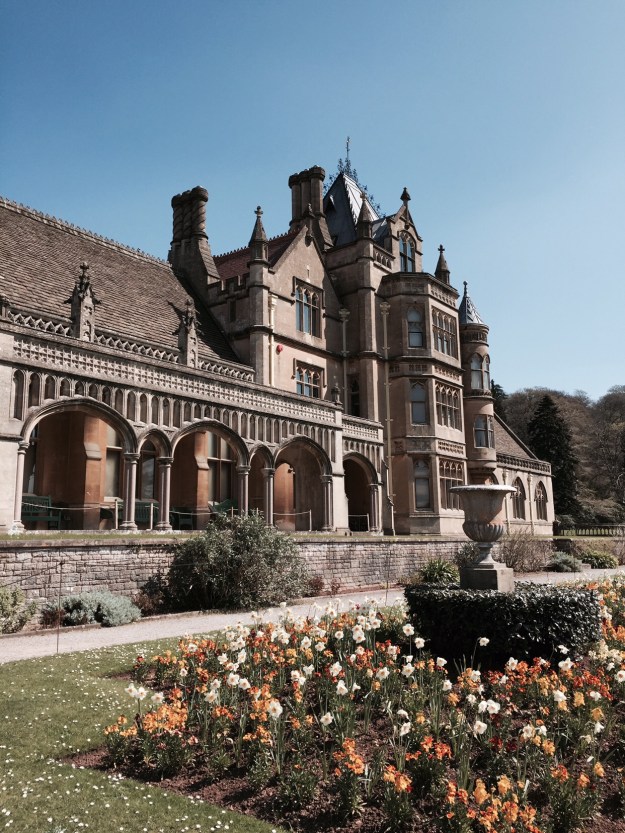The chapel at Tyntesfield is a spectacularly beautiful reimagining of a French medieval church, Sainte-Chapelle in Paris. Tyntesfield is a Victorian neo-Gothic mansion built by the devout Gibbs family, commoners who rose to great wealth through banking, shipping, and bat and bird manure (more on that later).
The chapel was the last big building project on the property, just outside Bristol, but it was in many ways the one most important to William Gibbs. It is also the first part of the house that the visitor sees on the walk from the parking lot and National Trust visitor center. It’s a stunning first impression. Arthur Blomfield was the architect and builder.
When the Gibbs family lived in their Victorian Gothic Revival mansion, the family, guests and servants alike attended prayers twice daily–first in the grand hall, and later in the chapel when it was finished. Beginning around 1842, William Gibbs made his fortune from a simple idea that grew and grew: he imported guano, the droppings of sea birds and bats, from Peru to North America. Guano was highly prized as a fertilizer. William Gibbs became the richest non-aristocratic man in England. Tyntesfield had 106 total rooms, with 26 main bedrooms plus more rooms for the many servants. The square footage is about 40,000. And this was only their country home. Most of the time they lived elsewhere, in equally grand digs.
Naturally, people were envious of Gibbs’s success. An indelicate ditty in London ran, “Mr. Gibbs made his dibs, Selling the turds of foreign birds.” Actually, the selling of fertilizer led inexorably to profiting from the slave trade, a fact which the Gibbs family preferred not to dwell on. Their shipping business, over time, became a part of the Triangular Trade that caused so much human misery. Ships constantly transported material goods and slaves between Europe, the Americas, and Africa.
The Gibbs family donated large amounts of their fortune to various charitable causes, and generously supported churches all over England. Naturally, they wanted their own church. The chapel was built between 1872 and 1879, to a design by Arthur Bloomfield. The inspiration was Sainte-Chapelle in Paris, pictured above. Sainte-Chapelle was built by the devout Louis IV in the 1240s. (He later became St. Louis, giving his name to the American city later still).The stained glass at Tyntesfield is beautiful, if not as spectacular as the newly-restored glass at Sainte-Chapelle in Paris.
The stonework is lovely and evocative.
WIlliam Gibbs intended to follow the example of aristocratic families and create a family burial vault underneath the chapel for future generations. The vault exists, but it is empty. The Bishop of Bath and Wells, under pressure from local churches, refused to consecrate the chapel. The stated reason was that allowing a consecrated chapel on the grounds of Tyntesfield would detract from local churches. I can’t help thinking that “the powers that be” were also reluctant to upset the social applecart by allowing a family of common birth to put on airs. (Eventually, George Abraham Gibbs was “created” 1st Baron Wraxall in 1928, but family fortunes were already declining by that time).The chapel at Tyntesfield is the last stop for visitors touring the beautiful mansion. It’s a lovely, light-filled, quiet place to contemplate history. William Gibbs was buried elsewhere, but a cross and inscription from the book of Proverbs memorialize his life: “The hoary head is a crown of glory, if it is found in the way of righteousness.” William Gibbs did his best to be both a businessman and a righteous man. Early in his career, he and his brother Henry worked hard to completely repay the debts that earlier family members had run up. The family business had gone bankrupt, and there was no obligation to pay. But they did anyway, every penny. It also appears that William Gibbs did his best to remove his shipping business from the slave trade once the terrible abuses were known.
I previously wrote about Tyntesfield and the Gibbs family at https://castlesandcoffeehouses.com/2014/10/22/high-victorian…at-tyntesfield/
https://castlesandcoffeehouses.com/2013/06/19/tyntesfield-vi…lendor-rescued/
An article about the restoration of St. Chapelle in Paris is at http://www.theguardian.com/world/2015/may/20/sainte-chapelle-paris-stained-glass-window-restoration-completed
Join me next time for more explorations in the art and history of Europe and the British Isles!





























